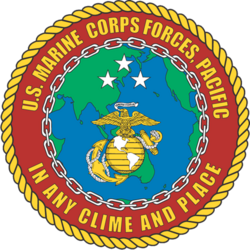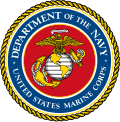| Marine Forces Pacific | |
|---|---|
 MARFORPAC insignia | |
| Founded | 31 July 1992 |
| Country | |
| Branch | |
| Size | 84,000 Marines and sailors |
| Part of | United States Indo-Pacific Command |
| Garrison/HQ | Camp H. M. Smith |
| Motto(s) | "In Any Clime and Place!" |
| Colors | Marine Corps Colors |
| Website | marforpac.marines.mil |
| Commanders | |
| Commander | LtGen James F. Glynn |
| Deputy Commander | MajGen Matthew T. Mowery |
| Colonel of the Regiment | SgtMaj Joy M. Kitashima [1] |
The U.S. Marine Corps Forces, Pacific (MARFORPAC) is the Marine Corps service component command of U.S. Indo-Pacific Command. It is the largest field command in the Marine Corps and is headquartered at Camp H. M. Smith in Hawaii. The MARFORPAC area of responsibility covers more than half of the Earth's surface.
Contents
It is composed of the I Marine Expeditionary Force (I MEF) and the III Marine Expeditionary Force (III MEF). Each MEF comprises a command element (CE), a ground combat element (GCE) (1st and 3rd Marine Divisions), an aviation combat element (ACE) (1st and 3rd Marine Aircraft Wings), and a logistics combat element (LCE) (1st and 3rd Marine Logistics Groups).


















